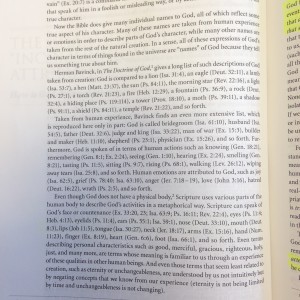One of my students and I are walking through Wayne Grudem’s Systematic Theology. Each week we read a chapter and then discuss specific doctrine and how it is applicable to our life and faith. We are only 200 pages into this 1,200 page beast, but plan to finish before he graduates in 2 years.
Our topic of discussion this past week was focused on God’s communicable attributes (attributes we share with God), and more specifically God’s spirituality and invisibility.
Gruden’s definition of spirituality:
“God’s spirituality means that God exists as a being that is not made of any matter, has no parts or dimensions, is unable to be perceived by our bodily senses, and is more excellent than any other kind of existence.”
Gruden’s definition of invisibility:
“God’s invisibility means that God’s total essence, all of his spiritual being, will never be able to be seen by us, yet God still shows himself to us though visible, created things.”
These two topics lead to great discussion about how we think of God and how we worship God in his fullness. For most of my life, I just pictured God as and old man with a huge grey beard and an intense look in his eyes. The student I was meeting with admitted that he only thinks about Jesus, and hadn’t given much thought to the appearance of the Father. Which isn’t the worst thing in that “Jesus is “the image of the invisible God” (Col. 1:15), and is “the bright radiance of the glory of God” and is “the exact representation of his nature” (Heb. 1:3).”
But it starts to mess with your brain when you think about the vastness of God, how we will never see Him in his fullness, in that we will always operate in one place and time where God is omnipresent and for Him to be fully present in one place means He would not be present in others.
I can tell this idea even messes with a great mind like Grudem. You can hear the wonder in his statement that “…we must say that God is spirit. Whatever this means, it is a kind of existence that is unlike anything else in creation.”
Application to Youth Ministry
So how do we talk about God to students? How do we describe what is indescribable? How do we define what is undefinable or even attempt to convey what is unmeasurable? Answer: Intentionally and faithfully. May we not limit the God we convey to students, but may we be diligent in conveying different parts of his nature, character, and love, that students might see, if only in part, the vastness and greatness of God.
Two ways to talk about God:
1. The names of God: In Scripture we see God called by different names, each of which reveal something about his nature. Here is a great list and study from Blue Letter Bible: Names of God (Also a great resource for studying scripture!)
2. Analogies or descriptions of God from Scripture: (Instead of recreating the list, here is what Grudem gives us in his Systematic Theology)
[guestpost]David Hanson: Texas native, Texas Tech Red Raider, M.Div. at Truett Seminary, husband to Ashley, father to Ava & Ben, Student Pastor at LifePoint Church in Plano, Tx, table tennis (ping-pong) extraordinaire, addicted to coffee. For anything else…you’ll just have to ask.[/guestpost]

